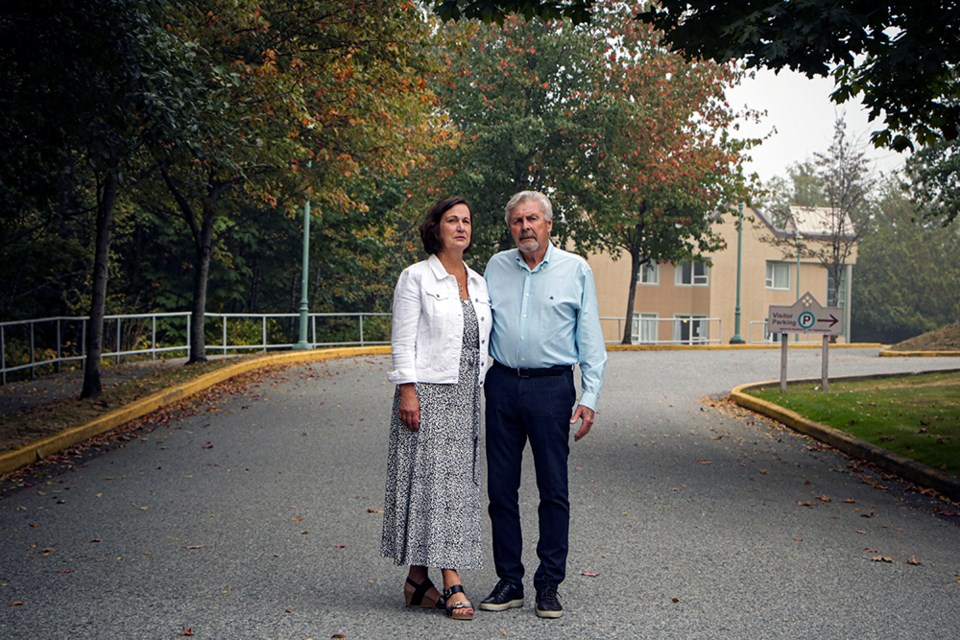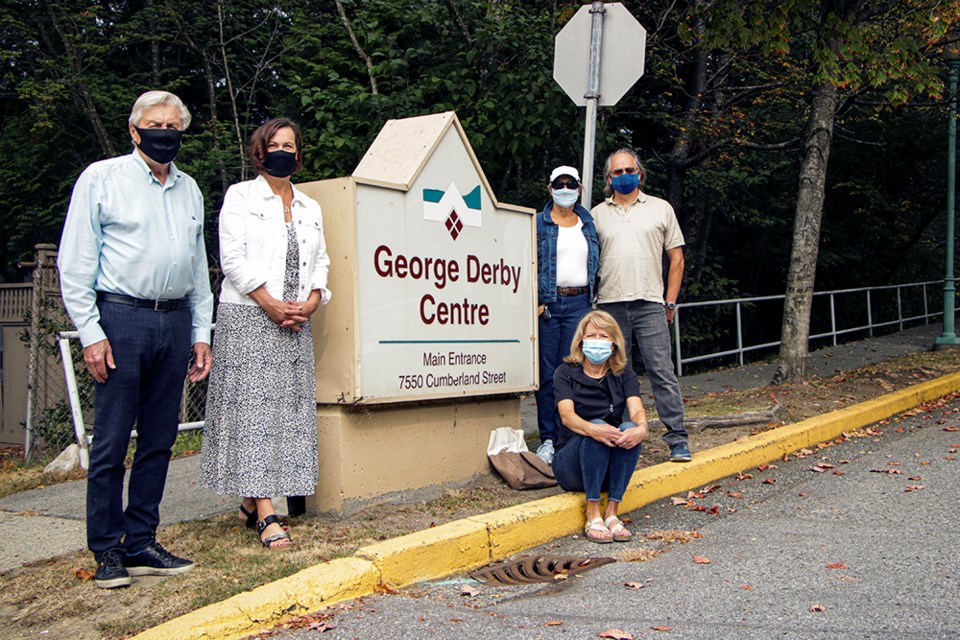Until early September, Mark Boyter thought he had no reason to worry about his mother-in-law, Jessie Switzer.
Until early September, Boyter thought there had only been two cases of COVID-19 since the outbreak at Switzer’s long-term care facility, Burnaby’s George Derby Centre, had begun a month prior. But when he was contacted by a family member of another resident on Facebook, he learned that no news is not necessarily good news – and that the centre had seen a total of seven cases, including one death.
Family members say the lack of transparency has caused significant anxiety for those trying to keep tabs on their loved ones’ situation.
“Within the space of two days, I've gone from thinking George Derby is doing the best they can to … it's far worse than they say, and they're not telling anybody,” says Boyter.
On Aug. 3, the George Derby Centre’s weekly update letter boasted, as it had every week since March, of a COVID-free environment. Four days later, Fraser Health announced an outbreak at the centre.
“We posted that (outbreak announcement), and we called all of the family members,” says Ava Turner, executive director of the George Derby Centre.
And while the Aug. 10 weekly update makes no mention of new cases since Aug. 7, every weekly update after that assures families that there had been no new confirmed cases that week.
Throughout the month, the Boyters figured the George Derby Centre was doing the best it could. But the longer they went without being able to contact Switzer, the more concerned they became.
The Boyters had bought a phone for Switzer to use, but at 100-and-a-half years old, she’s no longer able to hold it on her own. That means she, like many other residents, requires the help of the centre’s staff to participate in a Skype or phone call. That had been available throughout the pandemic – Turner notes the centre offered it without prompting from families. But once the outbreak hit the George Derby Centre, those lines of communication were shut off, as staff involved in the phone calls were now occupied with other tasks.
Boyter says he got a call saying family visits were no longer open, even though the outbreak was on the south side, and his mother-in-law lives on the north side.
“This is a problem, but it’s a pandemic. I get it. The good news is the outbreak is on the south side. So even though we can’t now talk to our mother, at least we know she’s safe because she’s, I think, being cared for, and the outbreak’s on the other side, a long way away,” Boyter says.
“But then weeks go on, and we still can’t talk to her, and neither of us can figure out why she can’t talk on the telephone.”

Boyter’s wife, Iris, called in and discovered her mother was on droplet alert, meaning there was potential for exposure to COVID.
“And this is just not possible,” Boyter says. “She’s been in a bubble since March, since early March, and she is in a section that has no cases.”
That, the family would soon learn, was not so. While nurses and other staff had been contained to working within their units early on, Turner says staffing issues led a staff member who had been working on the south side to be scheduled on the north side. She stressed, however, that this was before the outbreak occurred, though she didn’t say how long before.
“Once we were notified we were in an outbreak, no one ever moved from one side to the other side,” she says.
Still, Boyter asks how staff could have been moved between units this late in the pandemic.
“In March, we were making this up. We were all in panic mode; we didn’t know what was going on,” he said. “If it did happen, how come we weren’t notified that your mother-in-law might have been exposed?”
Boyter posted to the centre’s Facebook page, saying he was disappointed to hear about the potential “cross-contamination.” After that post, he was contacted by private message on Facebook by Robyn Moulson, a family member of another resident, asking for more information.
“I tell her the story, and I say, ‘But luckily, there’s only two cases.’ And she writes back and says, ‘There weren’t two cases; there were seven cases and one death,’” Boyter says. “And now I’m astonished.”
***
'Obviously done something correct'
“Every week, I provide an update,” Turner notes – and that’s been true not just since the outbreak was declared, but since the facility shut down in March.
“I’m too transparent to keep anything in, and families are important; my residents are important.”
According to the executive director, the firewall was put up not by her, but by Fraser Health, which sent a team to work with the centre during the outbreak.
“I was told I couldn’t put the numbers in because it’s going to cause a lot of issues. And it caused a lot of issues not to put the numbers (in). So I went back and forth, back and forth,” she says. “I wanted to put the numbers out immediately. As soon as I was told that I could, I put them up immediately.”
In an email statement, however, Fraser Health says facilities are free to provide updates on outbreaks to residents and families “if they choose to.”
“It is important that residents and families are kept informed about COVID-19 outbreaks at long-term care and registered assisted living facilities in our region. We have supported all facilities in ensuring communication is a priority in every outbreak,” reads the statement.
Indeed, Moulson points to Burnaby NOW coverage of the outbreak at another care home in the city, where an outbreak was declared within days of the George Derby outbreak. In its updates to residents’ families, the New Vista Society included occasional tallies of infections and updates on deaths at the home.
In all, that care home saw at least 43 positive cases – 25 residents and 18 staff – and nine deaths.
Turner says she’s proud of George Derby for preventing the spread of COVID beyond the seven cases and one death.
“In all of this, 300 beds – three residents,” she says, referring to the three COVID-positive cases. “We’ve obviously done something correct that this has not spread anywhere else.”
Turner took over operations of the centre two years ago. At the time, the centre had been facing financial turbulence, largely the result of declining funding from Veterans Affairs as the number of veteran residents declined.
“When I came, licensing was here every day, basically. I changed that whole persona.”
***
'Running into brick walls'

The 3 p.m. ritual is well-known by B.C. residents, and it’s even launched provincial health officer Dr. Bonny Henry into local stardom. Top health officials stand in front of cameras to answer media questions and give an update on the pandemic, including the number of new infections, hospitalizations and deaths. It’s a small window into the scope of the pandemic – a beacon of hope on good days and a bad omen on others.
“This is one of the things we’ve all been hanging on since this pandemic started,” says Moulson.
That’s why she found it to be “fairly odd” when she was repeatedly told by staff at the centre that they couldn’t tell her the number of infections in the care home.
“I just kept running into brick walls,” she says. “There was no real further information. Anytime that I asked how many cases (are) there, I was told, ‘We can’t tell you,’ which I thought was rather strange.”
Feeling stonewalled, she sought information elsewhere, including by emailing Henry’s office and contacting Fraser Health. The email to Henry was bounced back to the George Derby Centre, which called Moulson and still refused to provide numbers.
She then contacted a reporter who told her there were eight cases at George Derby.
“So then I’m panicking, and I can’t get any confirmation of this,” Moulson says.
By then, she had been in touch with other family members who were also feeling like they had been “getting an absolute runaround.”
“Which just adds to the fear level. This virus is all about fear, particularly when you’ve got elderly parents in a care home,” Moulson says. “You can’t even know how many numbers (of infections) there are. … It just makes us feel absolutely helpless.”
After she got in touch with Fraser Health, she says, she got a phone call from the George Derby Centre, and that’s when she finally got the numbers: seven cases, including four staff and three residents. One death.
Follow Dustin on Twitter at @dustinrgodfrey
Email [email protected]



